Mudhol Hound at a glance
| Names | Status | Origin |
| CRITICALLY ENDANGERED | India, Mudhol Taluk, Karnataka |
| Physical Traits |
|
The Mudhol Hound (Caravan Hound)
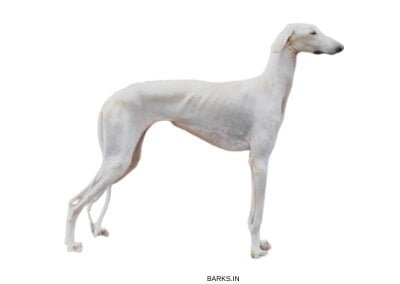
The Mudhol Hound is an Indian breed of dog found in the Deccan plateau region that borders the Indian states of Maharashtra and Karnataka. This dog breed originates from the Mudhol taluk and Bijapur in Karnataka. They are also known as the Indian Caravan Hound. People in Mudhol use names such as Pashmi and Karwani for this dog.
Mudhol Hound is a working sighthound. They are an able hunter and an endurance runner. When choosing a Mudhol breed, look for dogs with great stamina and endurance. The best Mudhol Hound dog is one who could run at pace, at the same time, sustain its pace over long distances.
When the Persians came to trade with India, they used these dogs to protect their caravan. These traders trained their dogs to run beside their trade convoys giving these dogs their name, Caravan Hound.

Mudhol Hounds have keen eyesight using which they can spot minute movements in the brush. Coupled with their excellent sense of smell, they can accurately pinpoint, hare, or Blackbuck. The heightened sense of sight and smell makes these dogs excel in hare coursing.
Like all other indigenous breed of dogs such as the Rampur Hound, Rajapalayam, Kanni, and the Chippiparai, this Indian breed is also critically endangered. This Desi breed is muscular and more substantial and resembles the Greyhound.
There are only a few who breed this dog. Efforts are underway to revive the Mudhol dog.
Due to its excellent temperament, trainability, speed, and endurance, the Indian Army uses this majestic breed in its ranks. Another reason for the Indian Army to prefer this dog is because this dog excels as a guard dog.
History of Mudhol Hound
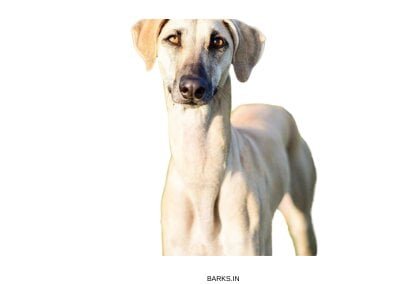
The Mudhol or the Caravan Hound is an Indian sighthound from Mudhol taluk in Karanataka state. In his book about native Indian dogs, renowned Indian dog expert Mr. Theodore Bhaskaran briefly presents the history of this Indian dog breed. He writes about ancient India’s trade with Arab nations, which brought Afghan and Saluki dogs into India. The Caravan Hound is a descendant of these dogs from the Middle East.
The Pashmi is a feathered variety of the Mudhol Hound breed, which looks similar to the Saluki. The presence of “feathering” indicates that Mudhol Hounds are initially from the Middle East, brought to India by Arabian traders to India’s Maratha region.

Why is the Mudhol Hound also called the Caravan Hound?

The name Caravan hound is a reference to the primary purpose of this dog. They were a caravan guard dog. These dogs arrived in the Deccan plateau along with the Arab traders who traveled in convoys of caravans.
Some of these dogs were left behind as gifts. People started using this dog to hunt small animals and as a guard dog.
Mudhol Hound brought back from near extinction
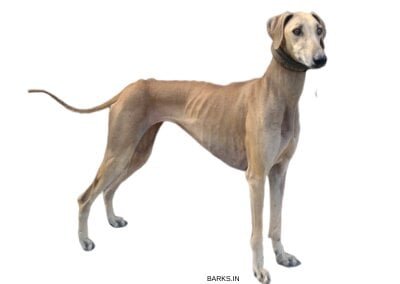
The Ghorpade dynasty ruled the Mudhol state from the mid 16th century. During the 1800s, there was a notable decline in the number of Mudhol Hounds. Malojirao IV Raje Ghorpade, the ruler of Mudhol and a dog breeder, led the efforts to revive this dog.
In 2015 a group of Mudhol dog enthusiasts came together to take steps for the protection of this dog. In a letter to the FCI, they highlighted the plight of this Indian breed. The Mudhol dog continues to survive because of the efforts of these people.
The Kennel Club of India organizes specialty native Indian dog shows to promote the native Indian dog breeds.
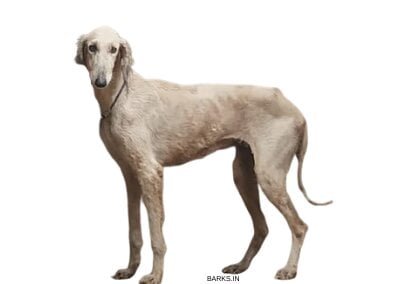
In the 128th all-breed championship dog show held by the Madras Canine Club, Kali, a Mudhol Hound won the best-in-show (BIS) and several other accolades. An international panel of judges adjudicated Kali as the BIS, which included not only native dogs but also foreign breeds of dogs such as the Labrador and the German Shepherd.
The purpose of the Mudhol Hound
There were two primary purposes for this dog.
- Caravan guard
- Hunter (coursing game)
The caravan guard
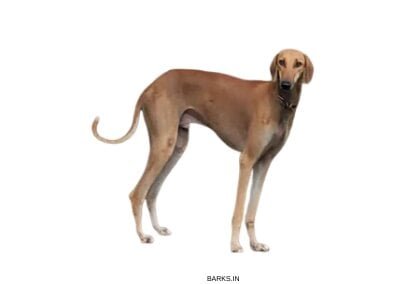
Arab traders brought their goods in convoys of horse-pulled caravans. The primary purpose of the Mudhol Hound was to run beside these caravans. Hence, this dog also goes by the name, Caravan Hound.
Hunter (coursing game)

The Mudhol Hound is a sighthound. Like any hound, this dog is a capable hunter. They have an excellent sense of sight and smell, which helps them to spot hidden game. According to unverified claims, these dogs are capable of hitting speeds up to 60 kph. Coupled with a slender, aerodynamic body, this dog excels in coursing.
The Mudhol Hound is an excellent guard dog and also a wonderful companion dog. Shepherds also use this dog to shepherd and guard their livestock.
The plight of the Mudhol Hound
The Mudhol Hound is another native Indian dog that is close to extinction. The Mudhol taluk is the primary breeding tract of this dog. With the introduction of foreign dogs, the demand for native Indian dogs has dropped, resulting in a drop in income for breeders. Slowly these magnificent native dogs are inching ever closer to extinction.
The following are some of the primary reasons for the current status of this dog.
- Ban on hunting
- Space and exercise requirements
- Inbreeding due to shrinking gene pool
- Neglect and lack of international recognition
The Karnataka Veterinary, Animal, and Fisheries University dedicated a Canine Research Center for the development of the Mudhol breed of dogs.
Ban on hunting

It is illegal to hunt in India. The Mudhol Hound is a hunter that can no longer fulfill its purpose. Before the ban on hunting, people relied on these dogs to hunt bush meat. Coursing was a popular sport where each breeder showcased the hunting skill of their dogs. With the hunting ban, people can no longer use their dogs for coursing game.
Space and exercise requirements
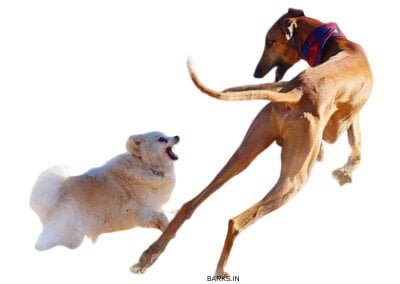
India is one of the fastest-growing economies of the world. People are moving away from villages and towns into cities. This dog is a hound that requires vast open spaces and tons of exercises. Most people living in cities cannot provide for a hound as time and space are at a premium.
Neglect and lack of international recognition

Import of foreign dogs, along with the factors listed above, are pushing the native dogs out. The internet, too, is filled with misinformation about this beautiful dog.
To our astonishment we found, there is not even one international kennel club that recognizes any of our native dogs. Slowly, the Caravan Hound is inching towards extinction.
Inbreeding due to shrinking gene pool
All of the above factors combined to create a ripple effect, inbreeding!. With fewer people breeding these dogs, there are fewer dogs to breed. Fewer dogs result in inbreeding. Inbreeding, in turn, affects the overall quality and health of the dogs.
Top speed of Mudhol Hound
This dog is unique among the Indian hounds. These dogs can hit speeds of 60 kph to 65 kph. Also, they are capable of sustaining this speed over long distances. Breeders choose dogs that can run at speed over long distances. This dog can work non-stop in hot weather.
Physical traits of the Mudhol Hound

The Mudhol Hound is a medium-sized dog that is slender, lean, and agile. The physical characteristics of the Mudhol Hound should indicate their purpose, ability to run long distances. The dog should give an impression of grace and elegance.
Powerful muscles on the legs, whip-like tail and a pointed head are hallmarks of the Mudhol hound. The dog should also be alert and ready to work.
Breeders have the practice of inserting a bangle through the muzzle of the dog. They say that the muzzle should reach the dog’s forehead. Unlike other fast hounds, the Mudhol Hound is an endurance runner. The dog should have great stamina and an ability to sustain high speed over long distances.
General Appearance

The general appearance of the Mudhol Hound should be of grace and elegance. This dog is never clumsy. The dog should symbolize its fitness and stamina. Bone structure and musculature should appear transparent beneath the dog’s smooth and lean skin. The dog has a rectangular structure, and they are longer than tall.
Head

The eyes of the Mudhol Hound should be almond-shaped. The eye color typically matches their coat. This sighthound has large eyes. This dog has drooping, and flat ears are set high on the skull. The ears are triangular with a rounded base.
The skull of the Mudhol Hound is flat and long. The muzzle blends into the head with a slight stop. The base of the skull should not be as broad as the top. The skull joins a lean and muscular neck. Jaws of the dog should close with a level bite. An overshot or undershot bite is a severe flaw.
Body
The body of the Mudhol Hound is lean, slender, and must exhibit fitness. This dog is never bulky. Dogs with long, and muscular are preferable over dogs with short necks. A long neck extends the reach of the dog and is a desirable trait.
The chest should be slender with visible ribs. The chest of the dog reaches down to 40% of the height of withers and blends into the abdomen. The tail is whip-like and is set low.
Legs

The legs are long, bony, and muscular. Dogs must have perfectly vertical legs without leaning towards any side. The legs blend into the body smoothly.
The gait should be graceful, elegant, and elastic. The legs should be perfectly synchronized, giving a neat and sleek appearance.
Coat and Colors
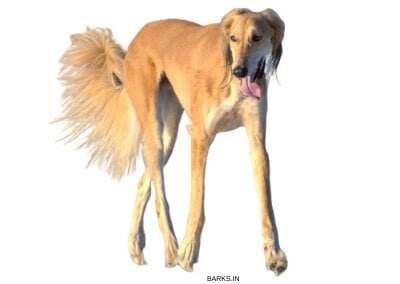
The Mudhol Hound is a single-coated breed of dog. Their single-coat is smooth with beautiful soft hair. This dog occurs in several colors. Fawn, brown, brindle dogs with white markings are common.
The Pashmi Hound has “feathering” on its ears and legs. They resemble their ancestor Saluki. However, Pashmi’s “feathering” is not as dense as the Saluki’s.
Mudhol Hound and its variants
The Mudhol Hound has a short and soft coat. The Pashmi is a variant of the Caravan Hound that has long hairs on its ears and legs.
The beautifully feathered Pashmi

The Pashmi dog is a variant of the Mudhol Hound, which has “feathering” on ears and legs. The Pashmi dog looks similar to the Caravan Hound’s ancestor, the Saluki. The presence of beautiful long hairs on the dog’s ears and legs indicates this dog’s Arabian origins.
The Pashmi does not have dense “feathering” like the Saluki. Additionally, Pashmi is an endurance sprinter, while the Saluki cannot sustain high speed over long distances.
Mudhol Hound versus other south Indian hounds
The Indian subcontinent is home to many beautiful sighthounds. The majestic Rajapalayam, the sleek Kanni, and the fast Chippiparai are from south Indian states.
We wanted to understand if the Indian sighthounds are related. India’s relationship with Persia dates back to the 5th and 6th centuries. Historical records during this early period record export of Tigers, monkeys, dogs, and parrots from India to Iran. Herodotus, a Greek historian, writes about a Persian king dedicating five villages for the maintenance of Indian dogs.
We also came across records for dogs brought into India from Persia. We can speculate based on the above historical information that all of the Indian hounds share a common ancestor. The ancestor might be a dog from the Middle East. Generations of selective breeding gave rise to these different sighthounds from South India.
The temperament of the Mudhol Hound

This dog is a one-person dog and gets along with family and friends. An aloof and dignified character describes this dog precisely. When treated with dignity, this dog makes an excellent companion. The Mudhol Hound does not like to be handled by strangers. We urge our readers to become thoroughly familiar with your dog before introducing them to strangers.
These dogs are also excellent guard dogs and are no pushovers. They will stand their ground and defend their territory. Most people in the Mudhol taluk use this dog as a guard dog.
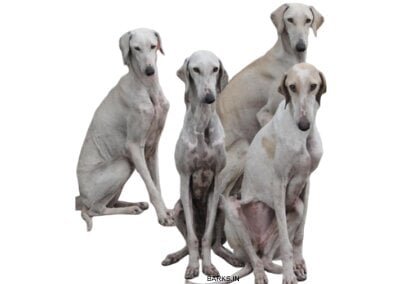
As puppies, these are super-active and playful dogs. Pet parents need to be careful when children and puppies are involved. A playful hound can push kids around.
These dogs prefer to live in a pack. People typically have two or three hounds. Having a companion helps the dog learn the pack’s social skills and keeps them engaged.
Care of the Mudhol Hound
The Mudhol Hound is well-suited to live and work in hot and humid conditions. These dogs have exceptional stamina and fitness; above all, a heart that is willing to work. We recommend that you provide the dog with a warm blanket and keep the dog indoors during cold winter nights.
The Mudhol Hound is a care-free dog with excellent disease resistance. They thrive in Indian conditions and can live all across India.
Grooming needs of the Mudhol Hound
Mudhol Hound’s short-single-coat does not require much grooming. Brushing their coat once a week keeps their skin in top condition. The Pashmi, on the other hand, need to be groomed every other day.
Shedding
The Mudhol Hound is a low shedding breed of dogs and doesn’t have body odor. They are couch friendly, and you will not notice hair on your furniture.
Exercise requirements of the Mudhol Hound
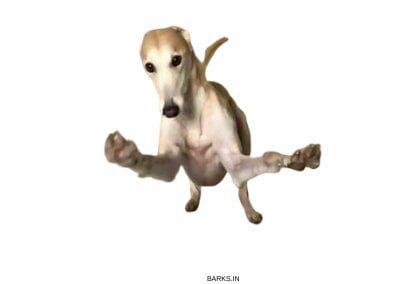
These dogs are fast, agile, and stamina. Like all hounds, the Mudhol Hound requires regular exercise for it to bit fit. Daily workouts help them vent out unspent energy in a positive way. If unexercised, these dogs can become bored and destructive.
The people in the native tract, alternate between running and walking exercises for these dogs. People take their dogs for long 3 to 4 km walks, and the next day, they run their dogs for 5 to 6 km.
Most dog owners have more than one dog; this they say enables them to reduce the exercise levels as dogs can play with each other. The Mudhol Hound is not suited for apartment living, and they need vast open spaces.
The trainability of the Mudhol Hound
The Mudhol Hound is a one-person dog. They have an aloof and stubborn disposition. The best way to train this dog is to start while they are puppies. Training this dog requires patience. For best results, keep your training sessions short. Remember, these dogs are sighthounds with fine-tuned senses. They can get easily distracted. It is best to keep the training sessions short.
The Mudhol Hound has high prey-drive. Learn to harness this while training the dog as a means of positive reinforcement. When the dog obeys, playing games like fetch or tug reinforces the behavior. This form of training is enjoyable for both the dog and its master. It also helps build strong bonds. With patience, time, and repetition, this dog can learn complex commands.
Nutritional needs of the Mudhol Hound
The Mudhol Hound requires nutrition that matches their level of activity. These dogs are highly active and require a diet that is high in protein and energy.
These dogs are susceptible to muscle tears, joint issues, and ligament tears. Ensure that your dog’s diet can provide the required amount of protein to heal these muscle-related issues.
In the native breeding tract, the Mudhol Hound lives on a meat-based diet. They thrive on homemade food. The Bidar people feed their dogs a bread they make from sorghum grain, goat milk, and meat.
A full-grown adult male Mudhol Hound living on a moderate amount of activity requires about 1300 to 1500 kcal each day. An active dog will need 1700 kcal per day.
Ensure that your dogs have access to a clean source of freshwater 24 hours a day. Even though these dogs have adapted to the harsh hot climate, your dogs must get sufficient water.
Known health issues
The Mudhol Hound is a disease-free dog. Generations of selective breeding have made these dogs resistant to most canine diseases. The following are some commonly seen health issues with this breed of dog.
- Seizures: Seizures are life-threatening and frightening convulsions that occur in dogs. Seizures are electrical misfiring in the brain that causes the suffering animal to lose control. Consult your vet if you notice seizure in your dog.
- Bloat: Dogs with a broad chest and a narrow abdomen are susceptible to Bloat. Bloat is a condition when the stomach or the gut of the dog twists internally. This twist stops the blood flow, and the stomach fills with gas. Don’t exercise or make your Mudhol Hound run just after a meal.

- Hypothyroidism: In this condition, the body doesn’t make enough thyroid hormone. The symptoms include dry skin and coat, hair loss.
- Mange: A microscopic mite infestation causes Mange in dogs. The signs include hair loss, itchy skin, and other skin related issues.
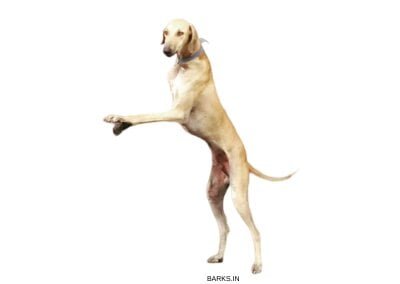
- Issues with tooth: Like us, our dogs can also suffer from dental issues. The Mudhol Hound’s long muzzle is prone to various dental issues including, tooth decay, bleeding gums, and bad breath.
- Issues with muscles: Mudhol Hounds are active dogs; they are an agile breed of dogs capable of running up to 65 kph. Your dog is prone to muscle issues such as a torn ACL, ligament tears, etc.
Natural home remedies for minor ailments
The Mudhol Hound is resistant to most canine diseases. The people in the native breeding tract rely on natural home remedies for their dogs. These home remedies are the first line of defense. As pet parents, it is crucial to learn these for a happy ownership experience.
- Dermatitis: Treat Dermatitis with a mixture of crushed Aloe Vera mixed with coconut oil and apply it over the dog’s body.
- Deworming: Young Neem leaves are crushed and then ground into a paste. This paste is rolled into pill-sized balls and dried in the sun. Feed one pill for 5 kg of dog’s weight to the dogs.
- Cuts: Turmeric is mixed with virgin coconut oil to form a thick paste. Treat cuts with this paste by applying it over the wound. Turmeric has antiseptic and antibiotic properties that heal. Coconut oil seals the wound.
Interesting Facts about the Mudhol Hound
- The Mudhol Hound is also known as the Caravan Hound.
- These dogs have a top speed of 65 kph.
- As Caravan Hounds, these dogs are known for their fitness and stamina. They can run for long distances.
- They thrive in hot and humid conditions.
- The Mudhol Hound is a loyal pet and a good guard dog.
What is the price of the Mudhol Hound?
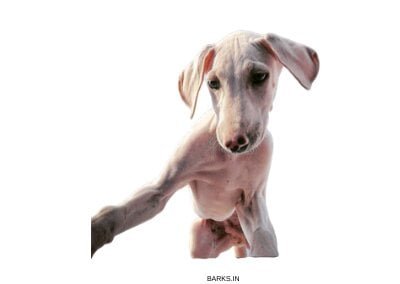
The cost of Mudhol Hound varies from one city in India to another. You can buy Mudhol Hound puppy from the Mudhol taluk for ₹7,000 to ₹10,000. Show quality pups cost more, and their price ranges from ₹15,000 to ₹25,000.
Choose puppies from the native breeding tract for two reasons.
- The income will encourage the breeders to continue with this breed of dog. You will help save this dog.
- Top-quality dogs are not the ones that win at the show. A top Mudhol Hound is a working dog, and you will only find them in their native tract.
Recommended Reading: Dog prices in India
When to choose a Mudhol Hound?
Choose the Mudhol Hound only when you meet the below criteria
- You have experience with dogs. The Mudhol Hound is a one-person dog that needs consistent leadership.
- You have time and space to provide for this agile Hound.
- You can take proper care of this dog. These dogs can live for more than ten years. Owning them is a commitment that you should make.
How to identify the original Mudhol Hound?
The Mudhol Hound is from the Mudhol taluk in the Indian state of Karnataka. They are slender, lean, and aerodynamically built sighthounds. You can read about them in this post and understand their traits.
We recommend that you speak to the breeders and visit dog shows before choosing a pup.
Where to buy a Mudhol Hound?
Choose a puppy only from its native breeding tract. Buying from breeders in the native tract will encourage them. The need of the hour is support and encouragement for the breeders.
How can I save the Mudhol Hound?
You can do any one of the below.
- If you are looking for a hound, then choose the Mudhol Hound. They are one of the best native hounds in India.
- Promote them on social media. All of us have a social presence; sharing articles creates awareness and dispels misinformation.
- Visit dog shows and encourage the native dog breeders.
- Buy native dogs only from the native breeding tract. Never buy puppies from breeders whose sole purpose is profit.
Conclusion
The Mudhol Hound is India’s endurance sprinter. This ancient and remarkable dog needs your help for it to survive. We urge our readers to choose native dogs. Native Indian dogs are easy to maintain, care-free, loving, and loyal. While all dogs are great (native or non-native), it is the native dogs that are inching towards extinction. They need your help to survive.

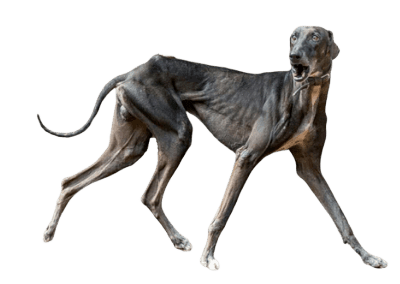
Nice to see a genuine attempt
Hi Rahul,
Thank you for your kind words.
Thanks
Robert
Hi Yogesh,
Thank you for reading our post. We hope you found the information useful. The typo error is now corrected. Thanks for pointing it out.
Thanks
Hi Yogesh,
Thank you for reading our post. We hope you found the information useful. The typo error is now corrected. Thanks for pointing it out.
Thanks
there is totally wrong information given about caravan mudhols and pashmis. you were going to face big trouble with the owners of that dogs whos pics you are used
they are three different breeds plz delet this post robert f
Hello Mr.Raj
Thanks for reading our post. I am sorry you feel the information presented here are inaccurate.
Our team and I can assure you, we do the best that we can in getting the right information to our readers. If you can let me know which information is wrong and give me the reference/authority that you used to compare our post. We are more than happy to correct any errors.
The pictures that you see on our post are sourced from
1. Pixabay, a free image gallery
2. Many pics are sent to us by our readers directly
3. Our team uses their contacts to get pics.
If you please let me know which pictures are under contention I will be happy to either get proper permission from the owner or take it down.
Once again we thank you for coming back to us. We are more than happy to correct any mistakes, provided you show us the source of your information
Thanks
Rob
Thanks
Robert
Hi Dr Yogesh,
You should be able to find an original Indian Pariah in villages in India. The common street dog in the city is not the original Indian Pariah. You can read all about Indian Pariah in our post (https://barks.in/indian-pariah-dog/).
Thanks
Hi Aravind,
The breeders whom I know don’t have a litter right now. You can facebook pages. It is best to buy this dog from a village than in city.
Thanks
Nice Reading Robert and good description of all aspects of the Breed since I owned own for 10 years. Now I am finding it difficult with all the social media,internet,e -commerce facilities etc to source a show quallity Mudhol pup.I tried the Canine institute you have stated,but requires a personal visit in Jan 21,not feasible in these times. i would like to promote pure mudhol Breed Hounds.I would apprecaite any info on the same. Thank you.
Hi Ramani,
Thanks for your kind words and reading our post. The best place to find Mudhol Hounds is through dog shows by KCI. You can also try dogsindia.com to find reputable breeders.
We have found it impossible to locate this beautiful dog by searching through social media. Internet again is filled with misinformation, our post too needs a lot of work to depict the true Mudhol Hound. The best way to find a Mudhol Hound is to be patient and by talking to a number of breeders.
Thanks